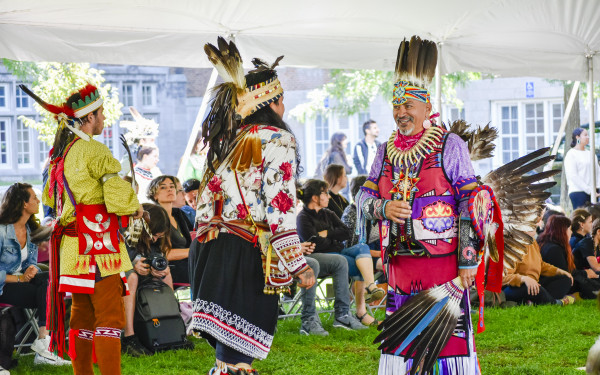Power Powwow
Black Bear Brings the Drum Circle to POP
Drum group Black Bear is having a powwow—and you’re invited.
An aboriginal powwow group, Black Bear hails from the Atikamekw Nation’s Manawan community. But they’re perhaps best known for their work with Ottawa-based First Nations group A Tribe Called Red.
A “powwowstep” group, A Tribe Called Red’s music is designed for urban First Nations youth in a dance club environment, but they’re careful not to have the electronic side to their music overshadow the traditional aspect of it. Their newest album Nation II Nation features a variety of aboriginal powwow groups that act as the base of their mixes, including Black Bear.
Keith-Michel Flamand, a member of Black Bear, was optimistic about the group’s participation with A Tribe Called Red.
“Mixing [powwow music] with electronic music is totally right,” Flamand told The Link. “A Tribe Called Red wants to create a new style and embrace tradition and they express it with their music.
“That’s a good thing because we don’t want to lose our identity,” he continued. “We were open to [their music] and allowed them to use our songs for their mixes.”
An Identity of Their Own
However exciting it was to work with A Tribe Called Red, featuring on their album didn’t change the way Black Bear performs.
Gilles Moar inadvertently founded Black Bear 13 years ago, when he began crafting traditional powwow drums for recreation. He started making them only for his sons and nephews, but the demand rose quickly and Moar eventually decided to make one big drum so a large group could all play together.
The emerging Black Bear group soon established a collection of songs and began performing in powwows around Quebec, going on to win Best Contemporary Powwow Album at the 2011 Aboriginal People’s Choice Music Awards.
At a powwow, the music emitted comes only from the hands and lips of those in the drum circle, creating an intimate and often spiritual atmosphere.
“It’s a community, a family. You feel proud about who you are,” Flamand said. “This is how people are at powwows. We share and we teach the younger ones.”
Modern-Day Powwow
While powwows are a long-established form of music, they have nonetheless evolved over the generations.
“The traditional songs are originally without words,” said Flamand. “In contemporary powwow, we put words in the songs while still embracing the traditional styles.”
Despite the differences, bringing tradition into a modern context has advantages as far as connecting within the community.
“Having some Atikamekw words in our songs, our community feels proud and encourages us not to stop what we’re doing,” says Flamand.
The Power of the Drum
The Atikamekw, like probably most other First Nations in Canada, are thrilled at the recent indigenous cultural resurgence that has been gaining momentum over the past few years.
“Today everyone is embracing their culture, […] getting more educated so they know what’s going on in their communities and their country,” said Flamand. “That’s a good thing for us, to sing and be agents, participating in this movement where people are going back to their traditions.
“First Nations are saying ‘enough,’” he continued. “They’re talking to not only the government, but all the people across the country. They want to be listened to.”
Flamand hopes he can reach out to these people as his influence in the community grows as part of Black Bear.
“I would like to gather more and more people year after year and teach them what’s going on in our country, along with what has been done in the past,” he said. “The drum has the power to gather people and it’s a good way to tell them to wake up.”
After their set, Black Bear will be hosting a question period, encouraging listeners to ask about and explore their music, culture and the powwow drum itself.
Black Bear // Sept. 28 // Little Italy Park (St. Zotique St., between St. Laurent Blvd. and Clark St.) // 12 p.m. // Free admission


2_600_375_90_s_c1.jpg)


1_600_375_90_s_c1.jpg)